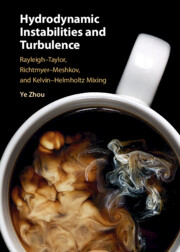 Hydrodynamic Instabilities and Turbulence
Hydrodynamic Instabilities and Turbulence Book contents
- Frontmatter
- Dedication
- Contents
- Preface
- Acknowledgments
- Part 1 Fundamentals
- 1 A first glimpse of Rayleigh–Taylor, Richtmyer–Meshkov, and Kelvin–Helmholtz instabilities
- 2 The linear stage for a singlemode
- 3 The nonlinear stage for a singlemode
- 4 Multimode instabilities: Linear and nonlinear regimes
- 5 Global features from the lens of integrated mixingmeasurements
- 6 Internal dynamics from the lens of statistical mixingmeasurements
- 7 Elementary aspects of turbulent flows
- 8 Transition to turbulence
- Part 2 Hydrodynamics of Complex Flows
- Part 3 From the Microscopic to Cosmic Scales
- References
- Index
5 - Global features from the lens of integrated mixingmeasurements
from Part 1 - Fundamentals
- Frontmatter
- Dedication
- Contents
- Preface
- Acknowledgments
- Part 1 Fundamentals
- 1 A first glimpse of Rayleigh–Taylor, Richtmyer–Meshkov, and Kelvin–Helmholtz instabilities
- 2 The linear stage for a singlemode
- 3 The nonlinear stage for a singlemode
- 4 Multimode instabilities: Linear and nonlinear regimes
- 5 Global features from the lens of integrated mixingmeasurements
- 6 Internal dynamics from the lens of statistical mixingmeasurements
- 7 Elementary aspects of turbulent flows
- 8 Transition to turbulence
- Part 2 Hydrodynamics of Complex Flows
- Part 3 From the Microscopic to Cosmic Scales
- References
- Index
Summary
We focus on three integrated measures of the mixing: the mixed-width, mixedness, and mixed mass. I will also examine the dependence of these mixing parameters on density disparities, Mach numbers, and other flow properties. It is shown that the mixed mass is nondecreasing. The asymmetry of the bubble and spike is also discussed.
- Type
- Chapter
- Information
- Hydrodynamic Instabilities and TurbulenceRayleigh–Taylor, Richtmyer–Meshkov, and Kelvin–Helmholtz Mixing, pp. 91 - 110Publisher: Cambridge University PressPrint publication year: 2024
